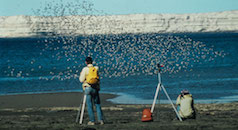According to NOAA’s Climate Prediction Center there is an approximately 95% chance that the current El Niño will continue through this winter, and evidence suggests that it may be one of the strongest on record.
While many people have heard about El Niño, without detailed knowledge of meteorology and climate science this phenomenon can be difficult to understand.
Every month the Climate Services team at Manomet writes a bulletin for our Climate Smart Land Network (CSLN) members where they discuss climate-related topics that have a direct impact on their operations. This month, it will address this familiar yet complicated topic of El Niño, as North American forests will likely be impacted by this climate pattern .
So, what is El Niño?
El Niño is the warm phase of an ocean-atmosphere circulation pattern in the equatorial Pacific Ocean, known as the El Niño-Southern Oscillation (ENSO). This natural phenomenon happens every two to seven years due to changes in the trade winds. The trade winds typically blow east to west in this region, pushing warm surface ocean water so it piles up in the western Pacific near Indonesia. When these winds weaken , the warm water “sloshes back” toward South America leading to the above average surface ocean temperatures that are characteristic of an El Niño event. When the trade winds strengthen, we see below-average sea surface temperatures in the same region, otherwise known as a La Niña (see figure, right).
This video from NOAA provides the latest update on El Niño conditions and expected impacts in the United States.
Why does it matter?
These changes alter global atmospheric circulation patterns and consequently have a big influence on temperature and precipitation throughout the world, including:
- Global Temperature – During an El Niño, enough extra heat is transferred from the ocean to the atmosphere that average global temperatures can rise as a result, which is why there is a good chance that this year will beat 2014 as the warmest year on record if there is an El Niño.
- Regional Weather – The domino effect caused by the warmer ocean surface during an El Niño leads to a shift in the jet stream that has implications for weather patterns in places like the United States, with the effects here predominantly felt in the fall and winter months.
The specific impacts of an El Niño event vary depending on the strength of the event and the extent of heat transfer between the ocean and atmosphere. The weather in some regions, like the Gulf Coast or southern California, is more directly influenced by El Niño conditions than other regions, such as New England, where we are more likely to experience a change in our regional weather if it is a particularly strong El Niño event. Here are some of the impacts that are generally associated with El Niño:
- Cooler and wetter-than-average conditions along the Gulf Coast from Texas to Florida
- Above-average temperatures and below-average snowfall in New England
- Warmer temperatures and less snowfall in the upper Midwest to Great Lake areas
- Drier-than-normal conditions across the Great lakes to the Ohio River Valley
- More severe weather in the southern U.S.
- More eastern Pacific hurricanes and fewer Atlantic hurricanes
- Wetter weather in southern California
“El Niño is one of the most well-known natural climate patterns, and it has a big influence on short-term variability in global climate,” explained Applied Forest Scientist Jennifer Hushaw. “We want to be sure CSLN members are up-to-speed on this topic because of the potential for El Niño-related weather to effect on-the-ground forest management operations, growing conditions, and wildfire risk.”
CSLN’s El Nino Bulletin will be published later this month, but in the meantime you can access all past bulletins on their website. Want to stay up-to-date? Contact Jennifer Hushaw if you would like to receive CSLN bulletins in your inbox as soon as they come out.





 Back to all
Back to all